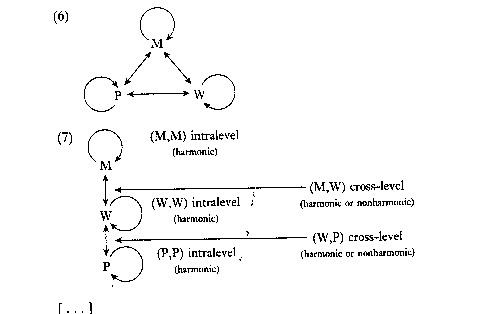Harmonic Phonology
Harmonic phonology in PHONOLOGY, an approach which recognizes three levels of REPRESENTATION working in parallel: MORPHOPHONEMIC (‘M-level’), WORD/ SYLLABLE tactics (‘W-level’), and PHONETIC (‘P-level’). Each level is characterized by a set of WELL-FORMEDNESS statements (‘tactics’) and a set of unordered ‘intralevel’ RULES which collectively define the paths an input representation has to follow in order to achieve maximum conformity to the tactics. This maximal well-formedness is called ‘harmony’. The levels are related by ‘inter- level’ rules. The approach avoids the traditional conception of the organization of a GENERATIVE grammar in which each level of representation is seen to precede or follow another (as would be found in the ordered steps within a DERIVATION)
(A phonological level will be defined as a set of phonotactics placed on representation. The word-level (W-level)in a particular language, for example, will consist of a set of phonotactics, or well-formedness conditions, that apply to phonological representations in that language. A general theory of word-level phonotactics will constrain the technical language in which such phonotatics can be specified, and the work discussed in this book suggests the following hypothesis: language-particular word-level phonotatics consist entirely of syllable structure-conditions, including autosegmental licensing specifications and autosegmental restrictions on the minimum/maximum number of associations. Other word-level phonotactics are universal. We return to some cases of this sort below.)

I will sketch eight areas where this approach shows a solid, coherent advantage over other approaches. These are intended as illustrative, not exhaustive, cases, as indicated above. If the suggestions considered here are correct, then the general principle of harmonic application governs all essentially phonological rule application.
(1) We often arrive at a considerable simplification of individual rules, as noted in party by Sommerstein, Singh, and Paradis, among others, when we do the following three things: (i) remove the structural description from the rule itself; (ii) invert it, specifying not what is disallowed, but rather what tactics must positively be met; and (iii) note that the positive conditions determining whether a rule will apply involve reference to the output of the rule, not the input-though, of course, an element in the input of the rule may be deleted in order that the output satisfy a condition.
(2) Finally, the distinction used here-between M-level, at which segmentally represented morphemes are represented, and W-level-motivates those uses of the Morpheme Tier Hypothesis that can be empirically motivation. The M-level representation is essentially devoid of phonological motivation; its representations may violate every conceivable phonotactics, every conceivable phonologically oriented constraint of the language. Its sole function is as a repository of the minimal information necessary to capture the sound characteristics of the morpheme. It is a structure that incorporates the morphemes that provide the realization of the morphosyntactic information. The W-level, on the other hand, is the level at which such phonological information is restructured in order to, aximally satisfy the language-particular organization principles which we call syllable and autosegmental phonotactics, of which licensing is an important, though not a unique,member. The W-level representation thus expresses the form the language squeezes its morphemes into in order to satisfy the alternating rhythm of consonants and vowels, of properly licensed coda and syllable material, of tonal association, and so on. The phonological rules of the language are its ways of manipulation the phonological substance present at the deeper M-level, and they express the options open to the language with regard to how much the language can ‘deform’ the underlying representation in order to maximally satisfy the multitude of competing demands of well-formedness at the W-level.
Thus, it seems reasonable that the morphological procedures responsible for constructing an M-level representation may produce a ‘pseudo-phonologized’ representation in which morphemes placed on separate tiers. The process of forming a W-level representation, then, requires what McCarthy calls tier conflation, which is one particular technique for restructuring an M-level representation into one that satisfies the universal and language-particular demands of W-level.

from Goldsmith, John A. 1999. Phonological Theory: The Essential Readings
Conclusions
The purpose of this theory is to explore the consequences for phonological analysis of assuming a different kind of relationship between underlying and surface forms than that which has traditionally been posited. Goldsmith (1999) discusses the problem from the point of view of reasonably traditional conceptions of phonological representations, modifying in some measure the notion of rule application and offering a representation of the traditional notion of level. Also, he reports on recent work that more radically changes the conception of phonological analysis by sharply reducing the conceptual distance between rules and representations and proposing specific means by which a phonological device can calculate its output in a dynamic fashion. This work, inspired in part by the computational tools of recent work in connectionism, provides a radically new p9icture of the dynamic functioning that occurs within a phonological level.
If this direction of research is correct, then the picture of phonology that emerges is one in which our notins of phonological structure, including autosegmental, metrical, and prosodic components, will rearise as the scaffolding in a network of phonological elements whose well-formedness is calculated on the basis of an interaction of neighboring units. Such structures, with their concomitant calculation of maximal well-formedness, will be found on each of the three phonological levels (and, presumably, on other linguistic levels as well, including syntax and morphology), and cross-level rules will ensure proper registration across levels.
Related Websites:
John Goldsmith Homepage: http://humanities.uchicago.edu/faculty/goldsmith/ (the representative of this theory)
Schools of Phonology: http://www.hltcentral.org/page-823.0.shtmlhttp://www.hltcentral.org/page-823.0.shtml
References:
Goldsmith, John A. 1993. The Last phonological Rule: Reflections on constraints and Derivations. Chicago: The University Press.
Goldsmith, John A. 1999. Phonological Theory: The Essential Readings. Oxford: Blackwell Publishers Inc.